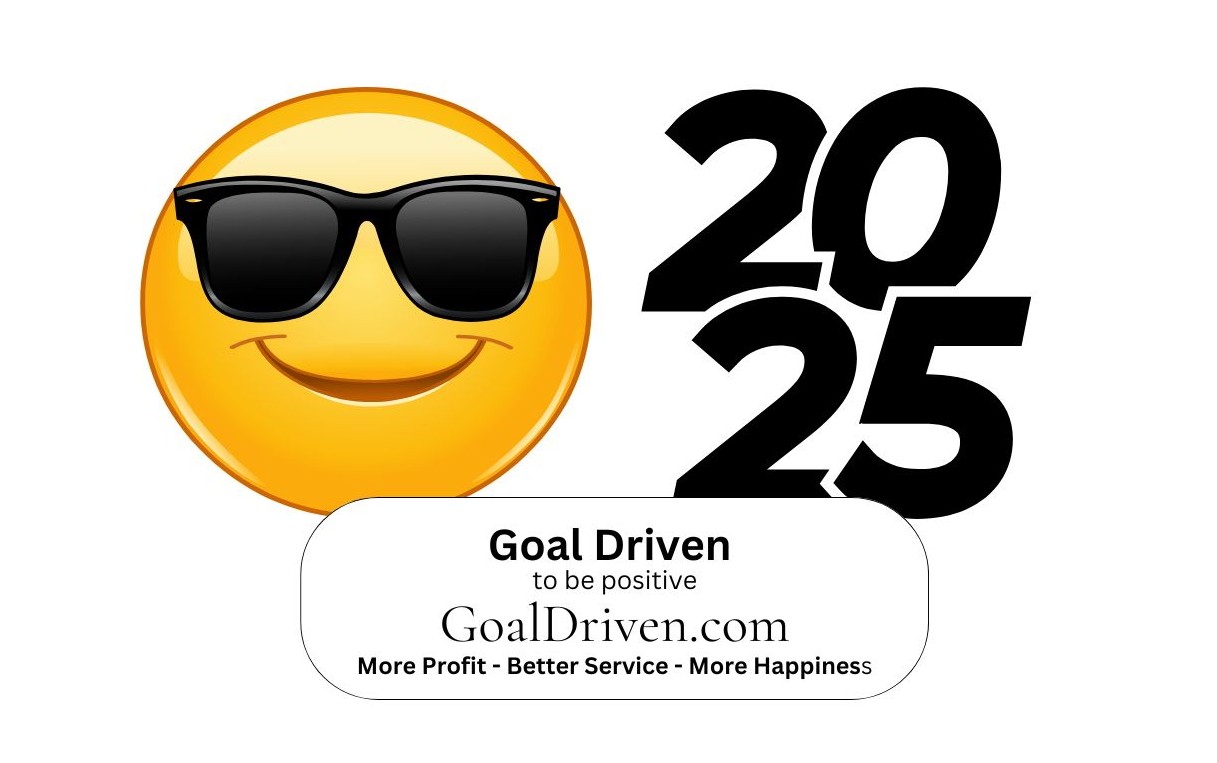What is the future of the solo practice of the chiropractic profession? Dave Michel was invited by Dr. Lauryn to share his opinion on her “She Slays the Day” podcast.
7 Steps to Creating Goal Driven Team Members

“The devil loves an idle mind.”
THE TRICK to keeping your practice lively, fresh and fun — and profitable, is to have your team set their own goals. Then, help them achieve them.
Without creative goals, we all can get bored. Attention drifts and performance and service slip.
According to Self Determination Theory, people want to have their own game. They want a degree of autonomy to demonstrate their competence in an activity they can control. They want their own sandbox.
Working in alignment with others in a group, people also want to be part of a community that shares a larger purpose – and is going somewhere.
This concept can be applied to your practice. Here is an example:
Steu Smalley (Steu has two major roles)
- Role: Billing and Collections. Goal: Collections, Collections Percent
- Role: Financial Consultation. Goal: Number of patients who accepted care, Percent of accepted care
Roseanna Danna: (Roseanna Danna has two major roles.)
- Role: Front Desk Coordinator. Goal: Total visits, Percent full capacity, Kept Appt. %
- Role: Internal Marketing. Goal: Patient referrals, Reactivated patients
It is understood that each office area depends on other areas, so teamwork is essential. However, everyone can improve the outcomes in their area.
Here are 7 steps to implement individual goals achievement.
- Define roles and goals. Define the major roles, goals, and statistics for each team member.
- Past statistics. Review past statistics if available.
- Set goals and action steps. Each team member should write down their goals and action steps for the upcoming one to three months.
- Copy to you. Team members provide you with a copy of their goals.
- Team meeting. Each team member should state their goals and action steps at the monthly team meeting so that everyone knows each other’s goals.
- Follow-up coaching. During the month, check in with each team member using the form they filled out and check their progress. Coach them as needed.
- Repeat the process each month.
Implement this program gradually, starting with key positions.
This approach promotes responsibility, accountability, and constant improvement while focusing on business goals. And it makes work more enjoyable.
We teach this procedure in our Practice MBA program for managers and clinic directors.
If you want management and leadership training for you and your manager or manager-to-be, please sign up on our waitlist. I will send updates soon with unique information about key tips on practice leadership, management, and marketing.
Seize your goals in 2025!
Ed
PS. MBA 2025. We are starting a wait list for our next MBA program, which will begin in March. We only take a limited number of students, so if you are interested, please get on our wait list here. [LINK]
Ask Lisa:Best End of Year Reports to Run to Prepare for Success in 2025
Know where your practice stands statistically going into the new year.
Happy New Year! Now that you’re back in the swing from the Holidays, we’ve put together for you a list of the most important reports we feel will prepare you for success in 2025! Have fun with running the below queries, while at the same time resolving to acknowledge the report outputs are your objective, x-ray analyses of where your practice stood in 2024.
1) Standard Financials/both month-to-month and January – December 2024 Practice stats. This will give you your new patient counts, your patient visits, your charges and your collections. What do you see month to month in terms of your high/low months? Did you do something different in the months that were higher statistically? And repeat that action!
2) Run your end of year Accounts Receivable. This is a number your accountant or CPA should ask for. You’ll need this for your balance sheet.
3) Review your Profit & Loss statements from month to month, run by either your accountant or your internal accounting software. Things to look for include:
a. Your expenses – were your expenses in line with your projected budget?
b. Your net income – were you able to pay yourself along with your associate(s) and staff salaries corresponding to livable wages?
4) Want to compare your expenses to what most chiropractic offices are doing? First, remember you want to compare you to you. But we can provide a breakdown of averages that you can look at and see where you may be high or low.
5) Accounts Receivables: 30/60/90+ days
a. Can these be reconciled? Expect 60% recovery for accounts to 60 days old; 55% recovery for accounts 60-90 days; and 20% recovery for accounts 90 days and older. The exception here is Personal Injury and Workers Compensation A/R, which are normally fully recoverable.
6) Retail Purchases – supplement/vitamin sales, pillow/therapy equipment (Durable Medical Equipment) sales.
7) Get your Sales and Use Report off your management software to your accountant or CPA by the end of January for filing the Sales Tax Report. You’ll also want to look at any independent contractors (cleaning services, IC massage therapists or other providers, snow plowing service, roofers, etc, etc) Provide their information and pay amount to your accountant by the end of January for 1099 preparation.
Once you have completed these reports and have assessed where your practice stands statistically, you can now:
• Update goals for 2025,
• Review your marketing efforts, and
• Review your retail inventory.
Need help with any of the above? Contact Lisa – I can help!
Lisa
lisa@pmaworks.com
920-334-4561
Chiropractic and Natural Healthcare Predicted to Grow

People want and need your services
Happy New Year!
Welcome to the First Newsletter of the New Year!
Thank you for being a valued subscriber and for your continued support throughout the past year. We truly enjoy creating these newsletters and hope they provide you with valuable insights to help you achieve your goals.
Our focus remains on practice growth and business development. We aim to assist you in enhancing both the quality and quantity of your services—ultimately boosting your bottom line. Along the way, we want to ensure you and your team enjoy the journey.
Don’t forget, Lisa, our expert in insurance, credentialing, and practice sales, also sends out a newsletter on the first Thursday of each month. Feel free to reach out to her anytime for expert advice. (Details about Lisa can be found below.)
CHIROPRACTIC GROWTH: A POSITIVE OUTLOOK
To kick off the New Year, our message is simple: Stay positive and goal-driven!
There is so much to be optimistic about, and I’ll be sharing solid reasons for this in the upcoming weeks. But let’s begin with one key piece of good news—the growth of chiropractic and natural healthcare.
The chiropractic profession is projected to expand at a compound annual growth rate (CAGR) of 26.3% between 2023 and 2033. This means the industry could grow from a yearly value of $571 million in 2023 to nearly $6 billion by 2033!

In comparison, the dental market is expected to grow at a much slower rate of just 4% annually.
While some forecasts for chiropractic growth are more conservative, most predict an increase of at least 10%. The study I reference appears to be well-researched, and you can read more about it on our blog (link below).
IT’S NOT JUST CHIROPRACTIC—NATURAL HEALTHCARE IS BOOMING
The growth isn’t limited to chiropractic care. Naturopathy, for example, is expected to grow by 15-20% over the next decade.
The organic food market has experienced significant growth as well. Sales, which were about $13 billion in 2005, surged to $64 billion in 2023 and are projected to reach $144 billion by 2032.
Similarly, the U.S. supplement market has exploded. In 2000, it was valued at $15 billion; in 2023, it reached $53 billion.
WHAT’S DRIVING THE GROWTH IN NATURAL HEALTHCARE?
The reasons behind this surge in natural healthcare are clear—especially for those of you working directly with patients. Americans are increasingly looking for ways to improve their health, and what’s been promoted to them for decades is no longer cutting it. As a result, they are turning to alternative solutions.
When comparing the health of Americans to other industrialized nations, the U.S. ranks near the bottom. Surveys indicate a significant shift in consumer attitudes towards proactive health management rather than reactive, symptom-focused treatments. There is also a growing preference for non-invasive, drug-free approaches.
In many cases, people are turning back to simpler, more natural remedies—sometimes even relying on what “Grandma knew”—as they seek alternatives to pharmaceuticals due to concerns about side effects and dependency.
Other key factors driving the growth of chiropractic and natural health include:
- Increasing Awareness and Acceptance: More people are becoming aware of the numerous benefits of chiropractic care.
- An Aging Population and Active Lifestyles: The incidence of conditions like back pain, arthritis, and sports injuries is on the rise—especially among seniors and those with sedentary lifestyles. Many are looking for non-surgical solutions, and with professional football teams utilizing chiropractors, weekend athletes are following suit.
- Integration with Traditional Medicine: There’s an increasing trend of collaboration between chiropractors and other healthcare providers. In fact, I personally know chiropractors working in hospital settings.
- Affordability: Chiropractic care is generally more cost-effective compared to many conventional medical treatments.
Your future looks bright – keep smiling!
As you can see, the future for chiropractic and natural healthcare is incredibly promising. Keep moving forward with optimism and a focus on your goals.
Let’s work together to make America healthier, one patient at a time!
For auld lang syne, my friend,
Ed
References on blog [LINK]
Create Something New Every Day in Your Chiropractic Healthcare Practice

It’s a unique aspect of human nature that we thrive when looking toward the future. (Victor Frankl)
No one—neither you, nor I, nor the people we work with—is holding us back from shaping a better tomorrow. We are the authors of our next chapter: 2025.
In the coming months, we have the freedom and opportunity to craft a renewed and enhanced version of our chiropractic practices and our lives.
Creativity is not only fun, but it’s also deeply meaningful and rewarding. It aligns with our natural drive to improve, to take something good and make it better, then share that improvement with the world.
As the New Year approaches, take some time to envision what 2025 could look like for you. Collaborate with your team and others—it’s a reminder that we all need each other.
This is your chance to innovate. Whether it’s rearranging your desk, adding new wall art, offering care classes, trying a new activity like line dancing, stepping up your fitness routine, or simply listening more attentively to others—don’t take things too seriously!
The key is to treat each day as a fresh start. This ties into the concept of Present Time Consciousness (P.T.C.), something I remember Dr. Jimmy Parker teaching us. When you’re truly present—living in the now—you open yourself up to creativity.
On the other hand, if you fall into autopilot mode, your days blur together, and each patient becomes just another routine. The monotony can be draining—and when you slip into this, it’s likely your team will too.
This is where a strong support system can make all the difference. No one can do it alone, so lean on your teammates, coaches, and colleagues to help you stay grounded and hold you accountable.
In 2025, commit to making every day new—treat each patient visit like it’s the very first. Avoid slipping into automatic mode. Step outside the algorithmic world, and embrace your humanity, spirituality, and Innate wisdom.
CREATE!
Let’s make 2025 your best year yet.
Seize the Future.
(Carpe Futurum)
Warmly,
Ed
Download a tent poster here: [LINK]
Merry Christmas to All

Delivering Kindness in Your Chiropractic Healthcare Practice
Multiple Appointment Scheduling Calendars -2025
Multiple Appointment Scheduling Calendars are helpful for increasing your patient retention. We take the work out of them by creating two different easy to use fully customizable forms.
Feel free to download them here.
Scheduling Calendars
Personal-Appointment-Calendar 2024(Customizable WORD Doc) (Portrait)
Appointment – Calendar 2024 (Customizable WORD Doc) (Landscape)
Personal-Appointment-Calendar 2025(Customizable WORD Doc) (Portrait)
Appointment – Calendar 2025(Customizable WORD Doc) (Landscape)
The Silent Recession and What to Do About it in your Chiropractic Healthcare Practice
Ask Lisa: Setting Up Finances With Your Patients
BJ Palmer had a quote: “Chiropractic is health insurance. Premiums small. Dividends large!”
Following this super quote, we have worked with offices for many years schooling them into implementing these mottos:
- We will accept all patients, regardless of their ability to pay, but we also must operate the clinic as a proprietary business, i.e., for profit, and the patient must want the care–not just “want a discount.”
- Each case will be individually handled and patients will receive a copy of their financial arrangements.
- Each patient file will have a copy of the patient’s individual financial arrangements.
How does the successful office achieve these goals?
First, to comply with Centers for Medicare and Medicaid’s No Surprises Act as a covered entity, each patient will have an idea what our range of charges are and that the charges will vary depending on what is done. Explain that the adjustment charges will vary from $XX to $XX, therapies will add $XX to $XX, and exams, diagnostic tests, etc. will add to that. Typically the average office visit will be from $30.00 to $140.00 per visit. This can be shared when the new patient calls in for their first appointment, or placed on your website.
Second, determine if you will be filing claims to insurance, and if patient has a copay or deductible. If there is a financial barrier with co-pays or deductibles, work with the patient during your meeting with them so that the patient does not drop out of care for financial reasons. To stay in compliance, note any waived fees or co-payments on your financial form, indicating why they were waived (no job, too many bills). Alert payment arrangements in your practice software so that the front desk and anyone doing follow-up knows exactly what the patient has agreed to pay each visit.
The patient should already have a good idea after Day 1 from the Report of Findings and the schedule you just worked out with them how many times they will be coming in. Ask the patient if they will have any problem with this and watch the patient to make sure that they will be comfortable with the fees you are presenting (previously calculated prior to meeting with patient).
(These next sections are specific to Wisconsin offices and offer examples. However, if you find this information interesting and you want more information and are outside WI, contact us for further information.)
If you are not filing to insurance, patients are considered self-pay. Let the patient know that they must pay at the time of service for any discount given. To be successful, you cannot reduce your fee while running up patient balances.
Any discount or special fee must be noted on the financial agreements and in the computer. The financial agreement must indicate why there are special discounts given. This can be simply noted in the space provided, such as “patient discount to $30 per visit-financial hardship” or “patient has just started new job-discount given to $30 per visit”. The CA or doctor, and patient, must sign the form.
For self-pay patients who can afford care, are on a routine schedule and show up, in order to give a discount they should be required to prepay, for a package of XX visits, typically with up to a 35% discount.
With the above policies in place, you can help many more people increase their health dividends, removing any financial barriers. Implementing these steps are key to expanding and growing your practice!
If you have any questions regarding financial arrangements and/or insurance please feel free to reach out to me.
Lisa Barnett
920-334-4561
lisa@pmaworks.com
Employee Satisfaction Scale and Chiropractic Practice Performance
The Benefits Of Counting Your Blessings in Chiropractic and Life

Thia article highlights the importance of gratitude in both chiropractic practice and life. It opens with a reflection on a life-changing encounter with Coach Johnny Pappa, whose motivational guidance left a lasting impact. Ed expresses regret for not recognizing the significance of such help at the time and not expressing gratitude sooner. This personal story serves as a reminder of the many people who have positively influenced our lives, often without acknowledgment.
As the article transitions to Thanksgiving Week, it underscores how gratitude is a transformative virtue, especially when life’s struggles or successes dominate our attention. The author references quotes from Tony Robbins and Cicero to emphasize that gratitude can foster emotional and physical well-being, improve relationships, reduce stress, and build mental resilience. It’s described as a virtue that not only enhances health and happiness but also promotes empathy and kindness.
The article concludes with a call to action for readers to reflect on their blessings and express gratitude to those who have supported them—family, friends, patients, and colleagues. The author thanks readers for their hard work and dedication, reinforcing the value of appreciation in both personal and professional life.
Read the full article here: https://www.goaldriven.com/post/the-benefits-of-counting-your-blessings-in-chiropractic-and-in-life
What Gets Measured — Gets Managed in Your Chiropractic and Service Business
Why 2025 Could Be Your Best Year in Chiropractic Practice

Ed touches on the reasons why 2025 could be a promising year for chiropractic practice owners and healthcare entrepreneurs.
Health Care Advocacy: Robert F. Kennedy Jr., a prominent advocate for health and environmental issues, has been vocal about his concerns with polluters and health agencies like the CDC and EPA. His activism, including his work against companies like Monsanto and ExxonMobil, has earned him recognition in the healthcare space. The incoming presidential administration, under President-elect Trump, is expected to grant Kennedy significant influence to address healthcare matters, providing optimism for the future of natural healthcare.
Support for Small Businesses: Elon Musk, a notable entrepreneur, is also involved in the new administration and advocates for the protection and growth of small businesses. Musk emphasizes that while starting a business can be challenging, the right environment can help independent businesses thrive. His support for entrepreneurship signals potential benefits for chiropractic and other small business owners.
Historical Legacy of Health and Fitness: The article also references the historical efforts of the Kennedy brothers in the 1960s to promote public health and fitness, such as fitness testing in schools and cleaner air and water standards. Musk’s own family background, with his great-grandfather being the first chiropractor in Canada, ties the legacy of chiropractic to modern entrepreneurship and innovation.
The article concludes with an optimistic outlook for healthcare entrepreneurs in 2025, encouraging chiropractic practice owners to think big and embrace opportunities for growth in the coming year.
Read the full article here: https://www.goaldriven.com/post/why-2025-could-be-your-best-year-in-chiropractic-practice
ASK LISA: The Vital Importance of the Post Report & Patient Financial Consultation
Greetings,
In our last two webinars, we discussed the importance of patient financial consultations.
Let’s delve into why they are so important to your bottom line and how you can set them up for success.
First, changes to insurance coverage and managed care have created an environment where third-party reviewers sometimes have more say in your patient’s length of care than you do.
Second, it is important to note that the financial consultation is a part of the overall Post Report. To be successful, all steps below should be reviewed and completed with each patient, whether they are new or re-activating their care. Why a post report?
The purpose of the post report is for the staff to fully address with the patient any obstacles to the patient getting the care they need and to set the patient up for their schedule of care. This includes setting up multiple appointment schedules, emphasizing the importance of staying on the schedule of care, discussing missed appointments, discussing any needed financial arrangements, going over how to check in at future visits, establishing where the patient should turn with questions or problems, and reassuring the patient in their decision to follow through with care.
Before you meet with the patient for the financial consultation, you also have to have a clear understanding of what you want to accomplish with your financial plans for patients. Your plans need to line up with the goals you have in your office and you need to individualize the plans. Do you want a high percentage of cash, wellness patients? An insurance-based family practice? PI or Work Comp acute care rehab practice? Is the patient undergoing a financial hardship? Each has a different set of criteria for tailoring patient financial agreements.
As these become more common, you can increase your patient retention and compliance by offering more OPTIONS for patient payments. Yes, this requires more work and more follow up, but adjusting to changing business practices in the world often require changing your internal procedures and policies. Adapt and offer ways to make care affordable, then promote these options so that patients see there is a way for them to get the care they need at a price they can afford.
Our Motto: Financial Plans are Liberal; Collections Policies Are Not.
This doesn’t mean reducing your fees or giving away services. On the contrary. For example, a new car costs many thousands more than your treatment plan, but auto dealers are adept at showing the customer ways they can drive that car home today.
Standardizing these procedures will ensure that your patients feel well taken care of at the office at all times.
Questions? We can help.
Click HERE for a sample care plan and financial plan template. [LINK]
Chiropractic End of Year Marketing and Business Checklist

This article provides a comprehensive checklist for chiropractors to prepare their practices for the end of the year and the upcoming new year. With 2025 just around the corner, the focus is on winding down advertising and shifting toward internal marketing strategies during November and December. Key ideas include:
- Holiday Promotions: Offer Thanksgiving turkey giveaways, special promotions for veterans, donation drives, and patient appreciation events like gift exchanges or holiday parties.
- Referral Programs: Encourage patient referrals with giveaways such as poinsettias and gift certificates, and express gratitude to external referral partners with thank-you gifts.
- Newsletters & Reminders: Send personalized practice updates and reminders to schedule appointments through the holidays.
Planning for the Future:
- Spend time with your team reflecting on 2024’s achievements and brainstorming goals for 2025. Consider creating a unifying theme or project for the year ahead.
Business Essentials:
- Financial Review: Meet with your accountant to assess finances and tax strategies.
- Employee Benefits & Contracts: Review employee benefits, consider bonuses, and evaluate insurance contracts for profitability.
- Compliance & Licensing: Ensure adherence to HIPAA and other regulations, and confirm that all licenses and malpractice insurance are in place for the coming year.
- Budget Planning: Set a budget aligned with your practice goals.
Start with a clear vision and remain focused on both immediate tasks and long-term objectives for continued success in the new year.
How To Achieve Your Biggest Goals: Lessons From an Astronaut
Insurance: The Changing Landscape & How to Best Prepare
Download the Slides: 2024-10-24- The Changing Landscape Slides
Does Your Chiropractic Practice Have Team Bonuses?
As a business owner, you want to reward success. Heck, you want to be rewarded for your success as well (at least one of these days! lol) It’s the American Way, right?
But, unfortunately, bonus systems don’t always work and aren’t always fair. Yet, within reason, we still recommend them.
Here are four basic needs and two types of motivation when rewarding employees.
Improving Your Chiropractic Practice Team Meetings
Team meetings can be very effective at improving the quality and quantity of your services.
At best, they bring everyone into alignment with the goals of the practice. They can release energy that results in sometimes almost magical results. I have seen it!
Here are some key tips for improving chiropractic practice team meetings:
1. Set Clear Goals and Structure
-
- Hold weekly meetings, ideally on Mondays to start the week strong
- Limit meetings to 1 hour maximum
- Create a consistent agenda covering key areas like practice goals, statistics, department updates, etc
2. Encourage Participation
- Require all staff to attend and come prepared to participate actively
- Allow time for each team member to report on their department
- Create an open forum for discussion and suggestions
3. Focus on Improvement
- Review practice statistics and track progress on goals
- Discuss what’s working well and what needs improvement
- Develop action plans to address any issues
4. Boost Motivation
- Start with positive affirmations or recognizing accomplishments
- Highlight exceptional work by staff members
- Share patient success stories to reinforce the practice’s mission
5. Maintain Professionalism
- Avoid criticizing individuals or changing policies during meetings
- End on a positive, inspirational note
- Follow up on action items and “to-do” lists from previous meetings
By implementing these strategies, you can transform your team meetings into productive, energizing sessions that align your staff and drive practice growth. Regular, well-run meetings are crucial for improving communication, motivation, and overall practice performance.
Read the full article here: https://www.goaldriven.com/post/improving-your-chiropractic-practice-team-meetings
========================
If your practice-building efforts aren’t taking you to your goals, there are reasons — many of which are hidden from you.
Find out what they are and how to sail to your next level by getting and implementing my book, The Goal Driven Business.

The Goal Driven Business






